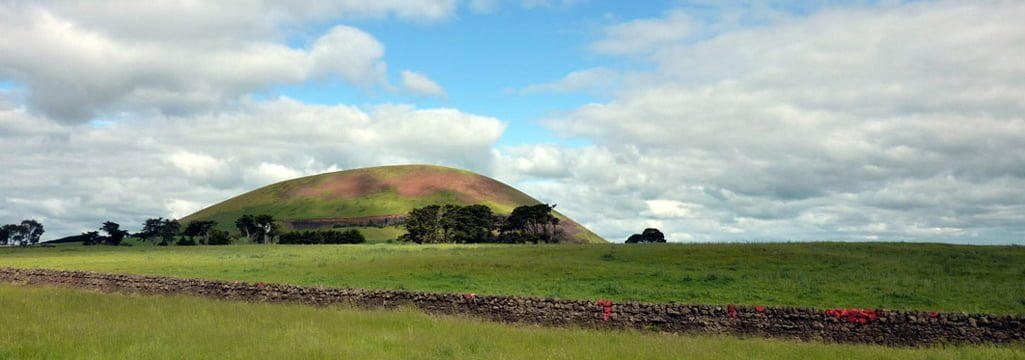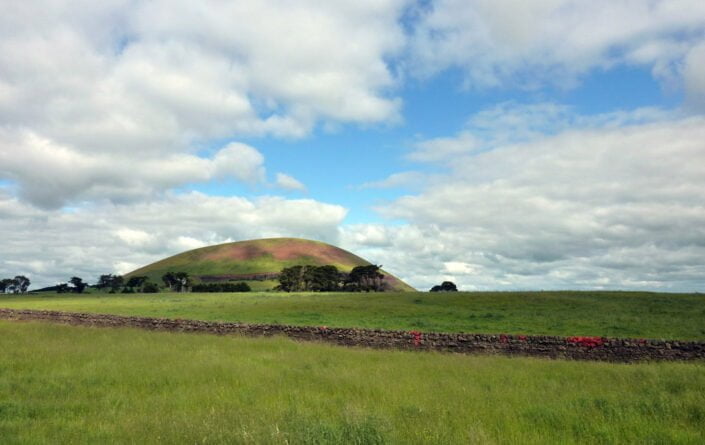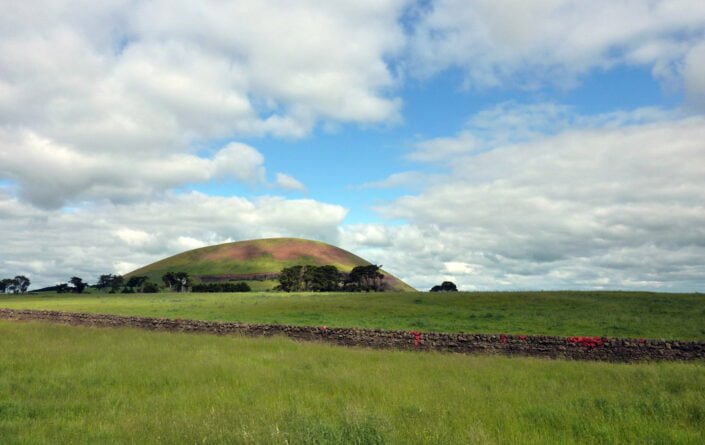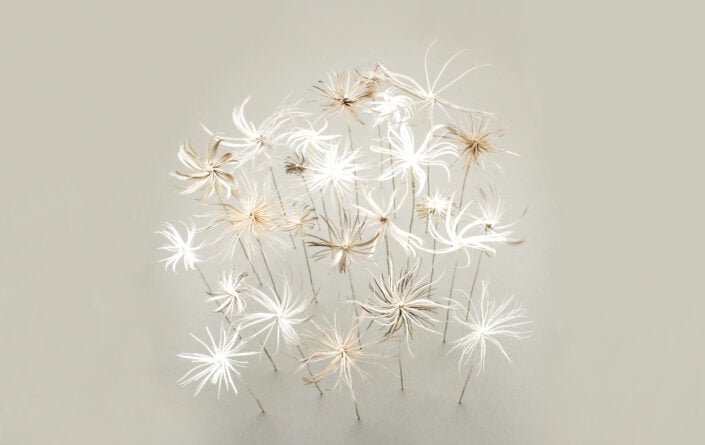Carmel Wallace
Discovery Bay offered me materials on its tide-lines: plastic broken free from cray-pots, and jettisoned cargo wedges once used to hold logs, including those from local forests, on ships bound for the paper mills of Japan. These collected materials – the texture of the wood; and the patterns of the grain – and the weathered triangular motifs that signpost the walk, became my palette, their repetition of form echoing the cadence of walking.
Signs of those who have walked the land before me, they speak of the way nature is negotiated by people in these particular environs: of the local fishing and forest industries and the movement of ships to and from the Port of Portland. Time spent in the elements, at sea and on the beach, is encoded in their shapes, colors and surfaces: the marks of human crafting modified by this environment, telling tales of a particular place over time.
Carmel Wallace
Walking a track along one of the wildest beaches of the southern coast, over cliffs skirting extensive middens in the sand dunes, Wallace engages with her home territory. Sensitive to the rhythms of tide and trail, and to the historical significance of the site, she has created distinctive works that focus on the way nature is mediated by people. In collected materials and journal notes, Wallace marks the ubiquitous terrain of human presence. Time and patina, are at the core of her connection to the landscape – embodied both in the materials themselves and in the time it takes to walk, to observe, and to collect.
Interview with Carmel Wallace
You initiated the Great South West Walk Art Project with Ilka White. Why was it important for you to instigate this project and undertake this journey?
One question that I keep returning to is how do we develop and maintain a meaningful relationship and sense of belonging to the land? I see this as a critical question underlying the way we treat and value our natural environment.
My desire to undertake this journey was driven in part by a need to develop my own knowledge and affinity for the land I live on and to explore how art might contribute to environmental solutions. I was looking forward to sharing time and ideas with other artists whose varied practices were, like mine, concerned with the way we negotiate and experience the natural world. The creative description and interpretation developed for the area would complement that of scientists and land managers, contributing to non-arts solutions and a cross-fertilisation of ideas about the valuing of this land.
I wanted to celebrate the remarkable, endangered natural environments cradled in this far south-western corner of Victoria; walking as an all-encompassing method of experiencing such environments; and the volunteers who recognised this before I did and built the Great South West Walk track.
Local communities are storehouses of knowledge, experience and stories that relate to particular environments. I saw this project as a vehicle for bringing this expertise to bear on the precious, endangered landscape traversed by the Great South West Walk. In David Suzuki’s words: Just as the key to a species’ survival in the natural world is its ability to adapt to local habitats, so the key to human survival will probably be the local community. If we can create vibrant, increasingly autonomous and self-reliant local groupings of people that emphasize sharing, cooperation and living lightly on the Earth, we can avoid the fate warned of by Rachel Carson and the world scientists and restore the sacred balance of life. (David Suzuki with Amanda McConnell, The sacred Balance: Rediscovering our Place in Nature, Allen & Unwin, Australia, 1997, p.8)
Did you have any preconceived ideas or plans for your work before embarking on the Walk?
Not really, although I did make the decision to use a step, rather than a minute or hour, to measure my progress along the track. I carried a stepcounter and small moleskin journals that were intimate and easy to carry. I planned to record sightings and experiences by entering them in my journal along with the number of steps I had taken that day to reach each point of observation. I wanted the physicality of walking to be embedded in these journals. It turned out to be a really useful methodology and my ‘Walking Journals’ and spontaneously captured notations became the basis of my Marking a Walk piece.
I also had a large piece of copper plate carried along with the camping gear. I planned to add dry-point recordings or images in the evenings at camp. I did make a start on this, but found myself thinking in quite different directions.
Once I got to the beach, I was compelled to pick up ‘unnatural’ detritus and drag it along behind me. I guess I knew I would do this as I walk the beaches of Discovery Bay as often as I can and always struggle back under a load of plastic, ropes, and other remnants of manufactured products from the fishing, shipping and other industries. This time though, I also recorded in my ‘Walking Journal’ things that were too heavy to retrieve as well as at which stage of the walk I came across the junk I did collect. In addition I recorded sightings of birds and the amazing array of marine life thrown up by the tides, including the carcass of a beautiful Wandering Albatross with a wing- span measuring nine of my walking boots in length.
How would you describe your artistic practice from concept to making?
The question of how we develop and maintain a meaningful relationship and sense of belonging to the land is at the core of my investigation as I see this as critical to the way we treat our endangered natural environment.
My local environment, which includes that traversed by the Great South West Walk, has always been my reference point. I have immersed myself in this landscape, and have studied it through many disciplinary paths in an effort to understand it as fully as possible.
As mentioned above, I often walk along the spectacular wild beaches of the south west coast and take bags with me so that I can collect ‘junk’ from the tide-lines. What I collect tells me so much, not only about this particular environment, but also about the greater world environment that produces and discards much of the waste that circulates in the ocean currents before ending up on these beaches.
Whatever the materials, time and natural processes are embodied in them. They are weathered and sea-sculptured. Surface and pattern, time and patina are embedded in the works I make with them. It takes me many walks over time (often years) to collect the critical mass of each material I need to make works such as those in this exhibition. The more I walk and collect, the more I learn and experience, the more connected I feel to this environment.
As a resident of Portland, what is it about the Great South West Walk that inspires you?
The construction of the Great South West Walk was in itself a visionary project that mobilised the local community and increased awareness and appreciation of the precious, unique environments on its doorstep. It allows people to access the natural world with minimal damage and plays a pivotal role in furthering knowledge and understanding of endangered environments. I have found walking to be a great way of immersing myself in the environment – to feel the sand slip under my feet and the wind whip my hair into knots; to smell the briny seaweed and hear the waves crash; to pick up a bleached bone and feel it in my hand; to feel enfolded in this world. What do you hope the viewer will take away from your work and the exhibition?
I would hope that the viewer would first of all appreciate the aesthetics of the works and then ask questions about where the forms and materials come from and what this tells them about contemporary society and our environment.
Carmel Wallace is represented by Gallery 101 (Melbourne)
2007Discovery Bay offered me materials on its tide-lines: plastic broken free from cray-pots, and jettisoned cargo wedges once used to hold logs, including those from local forests, on ships bound for the paper mills of Japan. These collected materials – the texture of the wood; and the patterns of the grain – and the weathered triangular motifs that signpost the walk, became my palette, their repetition of form echoing the cadence of walking.
Signs of those who have walked the land before me, they speak of the way nature is negotiated by people in these particular environs: of the local fishing and forest industries and the movement of ships to and from the Port of Portland. Time spent in the elements, at sea and on the beach, is encoded in their shapes, colors and surfaces: the marks of human crafting modified by this environment, telling tales of a particular place over time.
Carmel Wallace
Walking a track along one of the wildest beaches of the southern coast, over cliffs skirting extensive middens in the sand dunes, Wallace engages with her home territory. Sensitive to the rhythms of tide and trail, and to the historical significance of the site, she has created distinctive works that focus on the way nature is mediated by people. In collected materials and journal notes, Wallace marks the ubiquitous terrain of human presence. Time and patina, are at the core of her connection to the landscape – embodied both in the materials themselves and in the time it takes to walk, to observe, and to collect.
Interview with Carmel Wallace
You initiated the Great South West Walk Art Project with Ilka White. Why was it important for you to instigate this project and undertake this journey?
One question that I keep returning to is how do we develop and maintain a meaningful relationship and sense of belonging to the land? I see this as a critical question underlying the way we treat and value our natural environment.
My desire to undertake this journey was driven in part by a need to develop my own knowledge and affinity for the land I live on and to explore how art might contribute to environmental solutions. I was looking forward to sharing time and ideas with other artists whose varied practices were, like mine, concerned with the way we negotiate and experience the natural world. The creative description and interpretation developed for the area would complement that of scientists and land managers, contributing to non-arts solutions and a cross-fertilisation of ideas about the valuing of this land.
I wanted to celebrate the remarkable, endangered natural environments cradled in this far south-western corner of Victoria; walking as an all-encompassing method of experiencing such environments; and the volunteers who recognised this before I did and built the Great South West Walk track.
Local communities are storehouses of knowledge, experience and stories that relate to particular environments. I saw this project as a vehicle for bringing this expertise to bear on the precious, endangered landscape traversed by the Great South West Walk. In David Suzuki’s words: Just as the key to a species’ survival in the natural world is its ability to adapt to local habitats, so the key to human survival will probably be the local community. If we can create vibrant, increasingly autonomous and self-reliant local groupings of people that emphasize sharing, cooperation and living lightly on the Earth, we can avoid the fate warned of by Rachel Carson and the world scientists and restore the sacred balance of life. (David Suzuki with Amanda McConnell, The sacred Balance: Rediscovering our Place in Nature, Allen & Unwin, Australia, 1997, p.8)
Did you have any preconceived ideas or plans for your work before embarking on the Walk?
Not really, although I did make the decision to use a step, rather than a minute or hour, to measure my progress along the track. I carried a stepcounter and small moleskin journals that were intimate and easy to carry. I planned to record sightings and experiences by entering them in my journal along with the number of steps I had taken that day to reach each point of observation. I wanted the physicality of walking to be embedded in these journals. It turned out to be a really useful methodology and my ‘Walking Journals’ and spontaneously captured notations became the basis of my Marking a Walk piece.
I also had a large piece of copper plate carried along with the camping gear. I planned to add dry-point recordings or images in the evenings at camp. I did make a start on this, but found myself thinking in quite different directions.
Once I got to the beach, I was compelled to pick up ‘unnatural’ detritus and drag it along behind me. I guess I knew I would do this as I walk the beaches of Discovery Bay as often as I can and always struggle back under a load of plastic, ropes, and other remnants of manufactured products from the fishing, shipping and other industries. This time though, I also recorded in my ‘Walking Journal’ things that were too heavy to retrieve as well as at which stage of the walk I came across the junk I did collect. In addition I recorded sightings of birds and the amazing array of marine life thrown up by the tides, including the carcass of a beautiful Wandering Albatross with a wing- span measuring nine of my walking boots in length.
How would you describe your artistic practice from concept to making?
The question of how we develop and maintain a meaningful relationship and sense of belonging to the land is at the core of my investigation as I see this as critical to the way we treat our endangered natural environment.
My local environment, which includes that traversed by the Great South West Walk, has always been my reference point. I have immersed myself in this landscape, and have studied it through many disciplinary paths in an effort to understand it as fully as possible.
As mentioned above, I often walk along the spectacular wild beaches of the south west coast and take bags with me so that I can collect ‘junk’ from the tide-lines. What I collect tells me so much, not only about this particular environment, but also about the greater world environment that produces and discards much of the waste that circulates in the ocean currents before ending up on these beaches.
Whatever the materials, time and natural processes are embodied in them. They are weathered and sea-sculptured. Surface and pattern, time and patina are embedded in the works I make with them. It takes me many walks over time (often years) to collect the critical mass of each material I need to make works such as those in this exhibition. The more I walk and collect, the more I learn and experience, the more connected I feel to this environment.
As a resident of Portland, what is it about the Great South West Walk that inspires you?
The construction of the Great South West Walk was in itself a visionary project that mobilised the local community and increased awareness and appreciation of the precious, unique environments on its doorstep. It allows people to access the natural world with minimal damage and plays a pivotal role in furthering knowledge and understanding of endangered environments. I have found walking to be a great way of immersing myself in the environment – to feel the sand slip under my feet and the wind whip my hair into knots; to smell the briny seaweed and hear the waves crash; to pick up a bleached bone and feel it in my hand; to feel enfolded in this world. What do you hope the viewer will take away from your work and the exhibition?
I would hope that the viewer would first of all appreciate the aesthetics of the works and then ask questions about where the forms and materials come from and what this tells them about contemporary society and our environment.
Carmel Wallace is represented by Gallery 101 (Melbourne)
2007




